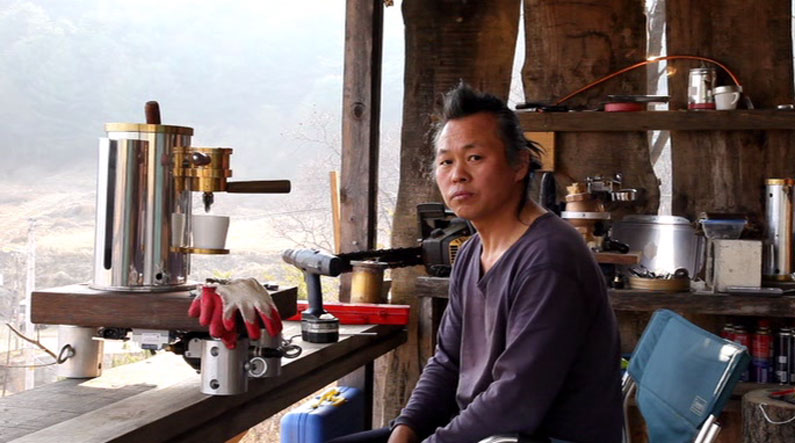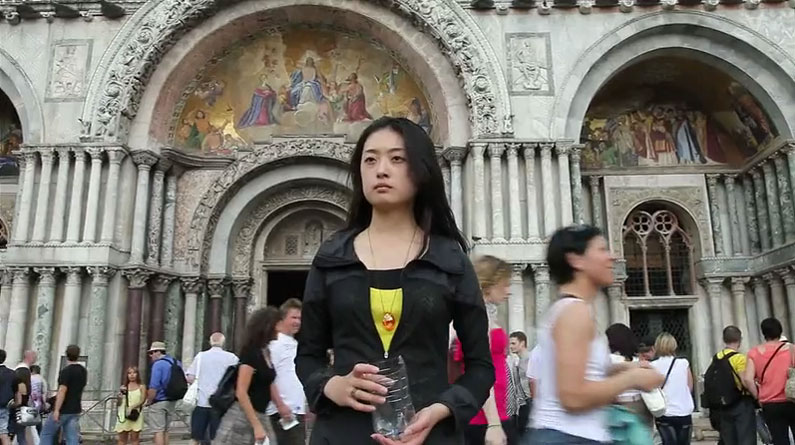“Life to me is sadism, self-torture and masochism,” notes Kim Ki-duk in his 2011 film Arirang. “Torturing others, getting tortured, and torturing oneself. Eventually, most people wish to settle for self-torture, right?” A darkly provocative thought. An instigation. Such is the nature of Kim and his work. Arirang, his 16th film, is an oddity, a break from the string of purely fictional provocations that have challenged and moved his viewers over the last dozen or so years. Instead, it is a film about the filmmaker, a hybrid fantasy-documentary covering three years in which Kim lived in a cabin and made no films. It is a starkly honest and at the same time brashly farcical exercise in self-reflection, narcissism, philosophy and raw living. It charts the psychological toll of creating dark fictional worlds — the sacrifices, wounds, uncertainties and practicalities of those worlds as Kim sees them. And as we see them through his films.

Kim’s work dwells in deep emotion; in stories of exposure and confession and struggle; in the painful journey of characters on a path of self-discovery. Life, according to Kim, is “really us fighting ourselves from within” and he has a natural gift for illustrating such deeply felt struggles in the strange and effecting rhythms of film.
In Arirang, what predominates is Kim’s face (singing, crying, tormented) expressing both the comfort and struggle of fate, the engine of living that he likens to combustion; to the raw forces of nature; to the cycling of light and dark. We watch him eating, drinking and talking to himself, addressing the cameras placed here and there in the cabin that is a sanctuary from his previous life — a closed-off intermission space he has constructed as a reprieve from a non-stop career of moviemaking. He reflects and confesses. He talks about his films. He struggles with their purpose and context. And he acts out theatrically, and sometimes absurdly.
As the film proceeds, we see that Kim’s real life and his fictional constructs are at one with each other and ultimately inseparable. There is no sharp line that divides them. What appears to be real shades into what appears to be fantasy. What ultimately remains is the mysterious fusion of fact and fiction that is narrative truth, that continually burning fire whose peculiar and effecting magic is the basis of Kim’s work; and of all compelling storytelling.
Amen is about the excessive strangeness of alienation; but also the truth about oneself that emerges through it. The premise: a Korean woman who has no money and sleeps on park benches wanders around Europe, searching for somebody whose name she yells out, while at the same time she is stalked (and assaulted while asleep) by a masked man in army fatigues. His actions mark a fundamental change in her mysterious life; she must come to terms with this. Her journey — searching, alone, tortured, aimless — is the bare plot of this experimental film.
In Arirang, Kim spoke of the absurdity of elaborate set-ups when it comes to filmmaking; of the idea that film can be as raw and unpolished as life. Amen is an attempt to put this idea into practice. It is ruthlessly guerrilla in technique; just hand-held cameras and (largely) one actress stumbling across a foreign landscape. There is practically no dialogue, but the noise of street life (wind, birds, traffic) is exaggeratedly loud throughout.
The woman is a beggar in a world to which she is largely absent, save for one figure, who increasingly sees her as the centre of life. And he is all she has, beyond the mute faces of statues in graveyards and a church, which seem to speak of a sadness and meaning beyond our grasp. She contemplates those faces and reflects them, for she is unwittingly cast into the role of the sacred. Her face — mostly sad, frightened or lost — is the focus of the narrative; a kind of mirror of elusive revelation.

And what of the odd mask that is so prominent in this film — another face, this one hidden and alien, threatening us with its incomprehension and menace. We expect the mask to be torn away, to reveal something unexpected, but that never really happens. Slavoj Zizek, in Less Than Nothing, provides a particularly cogent commentary on how masks can be interpreted and it applies particularly well to this film:
Wearing a mask can ... be a strange thing sometimes, more often then we tend to believe, there is more truth in the mask that what we we assume to be our “real self.” Think of the proverbial shy and impotent man who, while playing an interactive video game, adopts the screen identity of a sadistic murderer and irresistible seducer — it is all too simple to say that this identity is just an imaginary supplement, a temporary escape from his real-life impotence. The point is rather that, since he knows that the video game is “just a game,” he can “reveal his true self,” do things that he would never do in real-life interactions — in the guise of a fiction, the truth about himself is articulated.
In the end, the narrative and meaning of Amen remains frustratingly opaque. Perhaps it is an expressionistic exercise in documenting the lonely and dangerous pathways of an uncertain life; about how we are buffeted about by forces beyond our control, and make the best of wherever we end up. Or, more simply, it is Kim seeing what he can make of the barest of premises; of an actor and a director out in the world; of film as anti-film with no embellishments — a naked wandering into what one hopes will be a space of meaning in the din of life.
Pieta is a film about the excruciating void of loss. And yet it is also about revenge, coldness, sympathy, cruelty and the ruinous power of money in the lives of the desperately poor. The buzz of machinery, the lifeblood of a dwindling, impoverished community, reflects back on Kim’s environment in Arirang, where the filmmaker is surrounded by machines that heat or feed him.
In Pieta, he presents the people of this run-down community as individuals whose lives are deeply connected with their loved ones; whose difficult work and circumstances gain meaning through those unshakeable connections. And yet money, and the predatory lending scheme of a criminal gang, cripples and crushes the people of that community; they are at the mercy of debt and violence. This is the larger world writ small, a parable of economic injustice and the killing power of predation and greed.

Two lost souls anchor the film. One is a woman who seems to be continually crying; the other is a man who knows only cruelty and who seems to lack all access to an emotional life. He is a loan shark who metes out street justice over the ridiculously unfair terms of criminal agreements. What we learn early on is this: he could be the woman’s son. She haunts him. She won’t leave him alone. He threatens to kill her. She, in turn, asks him what he wants for dinner. Her continual kindness breaks through and, ultimately, breaks him down.
It is their relationship — the darkly mysterious connection between these two sad characters — that propels the story. Their souls have been profoundly darkened by the world. Can light be rekindled in them or is it too late? Can a broken individual crawl out of the squalid shadows of despair and evil and be loved again?